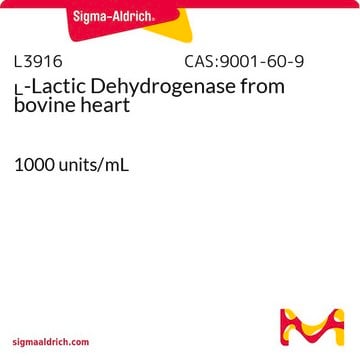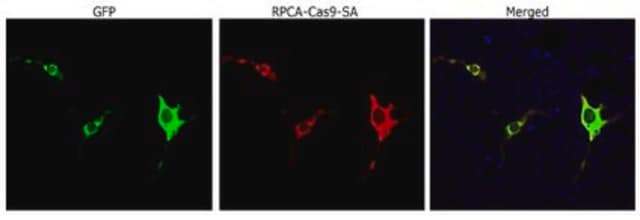General description
CRISPR-associated endonuclease Cas9 (UniProt: J7RUA5; also known as SaCas9, Cas9) is encoded by the Cas9 gene in Streptococcus aureus. Cas9 belongs to subtype II-A subfamily with one HNH Cas9-type domain. CRISPR (clustered regularly interspaced short palindromic repeat) is an adaptive immune system that provides protection against mobile genetic elements (viruses, transposable elements and conjugative plasmids). CRISPR clusters contain spacers, sequences complementary to antecedent mobile elements, and target invading nucleic acids. Cas9 has a bi-lobed architecture with a recognition lobe (residues 41-425) and a discontinuous nuclease lobe (NUC, residues 1-40 and 453-1053); the crRNA-target DNA lies in a channel between the 2 lobes. The NUC lobe has 2 endonuclease domains. The discontinuous RuvC-like domain in NUC cleaves the target DNA non-complementary to crRNA while the HNH nuclease domain cleaves the target DNA complementary to crRNA. Cas9 serves as a RNA-guided DNA endonuclease that cleaves double-stranded DNA targets with a protospacer adjacent motif (PAM) and complementarity to the guide RNA. The homologous region of the Streptococcus pyogenes is not closely related in amino acid sequence in S. aureus, hence this antibody does not recognize that protein.
Specificity
This chicken polyclonal antibody detects Cas9 from Staphylococcus aureus. It targets an epitope within 251 amino acids from the C-terminal end. This antibody does not react with Cas9 from Streptococcus pyogenes.
Immunogen
Epitope: C-terminus
His-tagged recombinant fragment corresponding to 251 amino acids from the C-terminal end of CRISPR-associated endonuclease Cas9 from Staphylococcus aureus.
Application
Anti-Cas9 (Chicken Polyclonal), Cat. No. AB356492, is a highly specific chicken polyclonal antibody that targets CRISPR-associated endonuclease Cas9 and has been tested in Immunofluorescence and Western Blotting.
Research Category
Epigenetics & Nuclear Function
Western Blotting Analysis: A 1:1,000 dilution from a representative lot detected Cas9 in HEK293 cells transfceted with GFP-Cas9 from Staphylococcus aureus (Courtesy of Dr. Gerry Shaw).
Immunofluorescence Analysis: A 1:1,000 dilution from a representative lot detected Cas9 in HEK293 cells transfceted with GFP-Cas9 from Staphylococcus aureus (Courtesy of Dr. Gerry Shaw).
Quality
Evaluated by Western Blotting in HEK293 cells transfected with GFP-Cas9 from Staphylococcus aureus.
Western Blotting Analysis: A 1:2,000 dilution of this antibody detected Cas9 in 40 µg of lysate from HEK293 cells transfected with GFP-Cas9 from Staphylococcus aureus.
Target description
~57 kDa observed. Uncharacterized bands may be observed in some lysate(s).
Physical form
Chicken polyclonal antibody in PBS with 0.02% sodium azide.
Format: Unpurified
Unpurified
Storage and Stability
Stable for 1 year at -20°C from date of receipt. Handling Recommendations: Upon receipt and prior to removing the cap, centrifuge the vial and gently mix the solution. Aliquot into microcentrifuge tubes and store at -20°C. Avoid repeated freeze/thaw cycles, which may damage IgG and affect product performance.
Other Notes
Concentration: Please refer to lot specific datasheet.
Disclaimer
Unless otherwise stated in our catalog or other company documentation accompanying the product(s), our products are intended for research use only and are not to be used for any other purpose, which includes but is not limited to, unauthorized commercial uses, in vitro diagnostic uses, ex vivo or in vivo therapeutic uses or any type of consumption or application to humans or animals.





